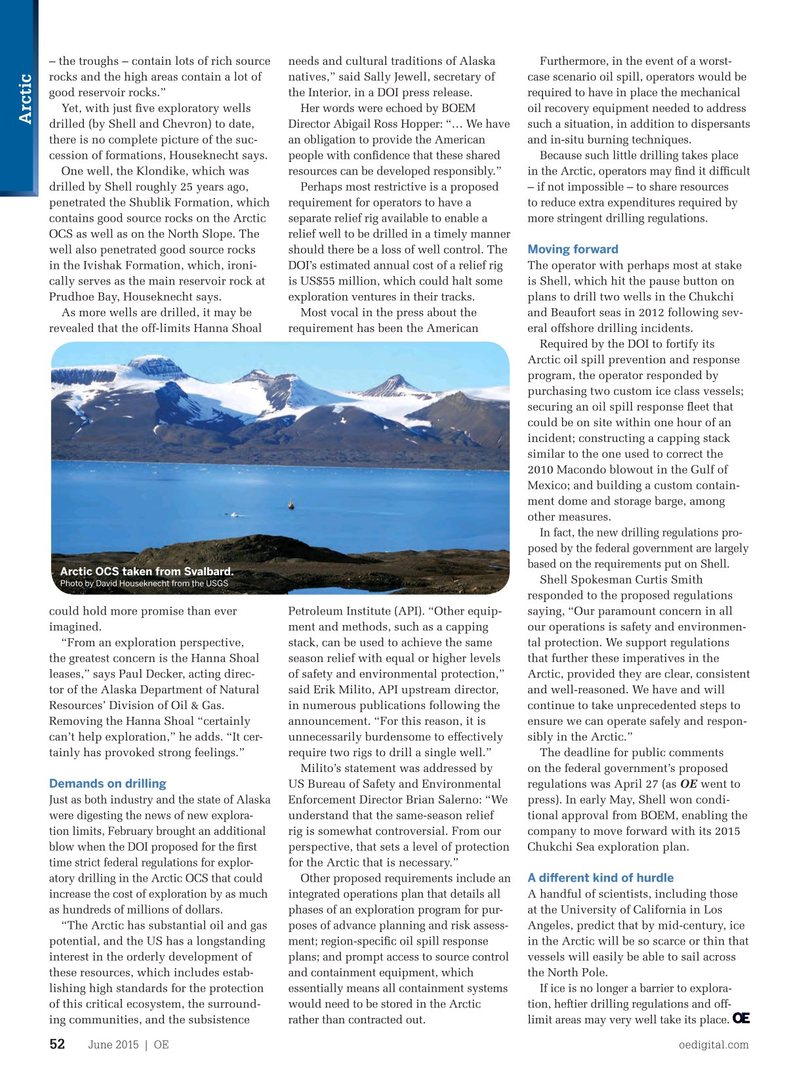
Page 50: of Offshore Engineer Magazine (Jun/Jul 2015)
Read this page in Pdf, Flash or Html5 edition of Jun/Jul 2015 Offshore Engineer Magazine
– the troughs – contain lots of rich source needs and cultural traditions of Alaska Furthermore, in the event of a worst- rocks and the high areas contain a lot of natives,” said Sally Jewell, secretary of case scenario oil spill, operators would be good reservoir rocks.” the Interior, in a DOI press release. required to have in place the mechanical
Her words were echoed by BOEM
Yet, with just fve exploratory wells oil recovery equipment needed to address
Arctic
Director Abigail Ross Hopper: “… We have drilled (by Shell and Chevron) to date, such a situation, in addition to dispersants an obligation to provide the American there is no complete picture of the suc- and in-situ burning techniques. people with confdence that these shared Because such little drilling takes place cession of formations, Houseknecht says. resources can be developed responsibly.” in the Arctic, operators may fnd it diffcult
One well, the Klondike, which was – if not impossible – to share resources drilled by Shell roughly 25 years ago, Perhaps most restrictive is a proposed to reduce extra expenditures required by penetrated the Shublik Formation, which requirement for operators to have a more stringent drilling regulations.
contains good source rocks on the Arctic separate relief rig available to enable a
OCS as well as on the North Slope. The relief well to be drilled in a timely manner
Moving forward well also penetrated good source rocks should there be a loss of well control. The in the Ivishak Formation, which, ironi- DOI’s estimated annual cost of a relief rig The operator with perhaps most at stake cally serves as the main reservoir rock at is US$55 million, which could halt some is Shell, which hit the pause button on
Prudhoe Bay, Houseknecht says. exploration ventures in their tracks. plans to drill two wells in the Chukchi
As more wells are drilled, it may be Most vocal in the press about the and Beaufort seas in 2012 following sev- revealed that the off-limits Hanna Shoal requirement has been the American eral offshore drilling incidents.
Required by the DOI to fortify its
Arctic oil spill prevention and response program, the operator responded by purchasing two custom ice class vessels; securing an oil spill response feet that could be on site within one hour of an incident; constructing a capping stack similar to the one used to correct the 2010 Macondo blowout in the Gulf of
Mexico; and building a custom contain- ment dome and storage barge, among other measures.
In fact, the new drilling regulations pro- posed by the federal government are largely based on the requirements put on Shell.
Arctic OCS taken from Svalbard.
Shell Spokesman Curtis Smith
Photo by David Houseknecht from the USGS responded to the proposed regulations could hold more promise than ever Petroleum Institute (API). “Other equip- saying, “Our paramount concern in all imagined. ment and methods, such as a capping our operations is safety and environmen- “From an exploration perspective, stack, can be used to achieve the same tal protection. We support regulations the greatest concern is the Hanna Shoal season relief with equal or higher levels that further these imperatives in the leases,” says Paul Decker, acting direc- of safety and environmental protection,” Arctic, provided they are clear, consistent tor of the Alaska Department of Natural said Erik Milito, API upstream director, and well-reasoned. We have and will
Resources’ Division of Oil & Gas. in numerous publications following the continue to take unprecedented steps to
Removing the Hanna Shoal “certainly announcement. “For this reason, it is ensure we can operate safely and respon- can’t help exploration,” he adds. “It cer- unnecessarily burdensome to effectively sibly in the Arctic.” tainly has provoked strong feelings.” require two rigs to drill a single well.” The deadline for public comments
Milito’s statement was addressed by on the federal government’s proposed
Demands on drilling
US Bureau of Safety and Environmental regulations was April 27 (as OE went to
Just as both industry and the state of Alaska
Enforcement Director Brian Salerno: “We press). In early May, Shell won condi- were digesting the news of new explora- understand that the same-season relief tional approval from BOEM, enabling the tion limits, February brought an additional rig is somewhat controversial. From our company to move forward with its 2015 blow when the DOI proposed for the frst perspective, that sets a level of protection Chukchi Sea exploration plan.
time strict federal regulations for explor- for the Arctic that is necessary.”
Other proposed requirements include an A diferent kind of hurdle atory drilling in the Arctic OCS that could
A handful of scientists, including those integrated operations plan that details all increase the cost of exploration by as much at the University of California in Los phases of an exploration program for pur- as hundreds of millions of dollars.
“The Arctic has substantial oil and gas Angeles, predict that by mid-century, ice poses of advance planning and risk assess- potential, and the US has a longstanding in the Arctic will be so scarce or thin that ment; region-specifc oil spill response interest in the orderly development of vessels will easily be able to sail across plans; and prompt access to source control and containment equipment, which these resources, which includes estab- the North Pole.
If ice is no longer a barrier to explora- essentially means all containment systems lishing high standards for the protection tion, heftier drilling regulations and off- would need to be stored in the Arctic of this critical ecosystem, the surround- limit areas may very well take its place. rather than contracted out.
ing communities, and the subsistence
June 2015 | OE oedigital.com 52 050_OE0615_Geo1_Heather.indd 52 5/31/15 9:23 PM

 49
49

 51
51